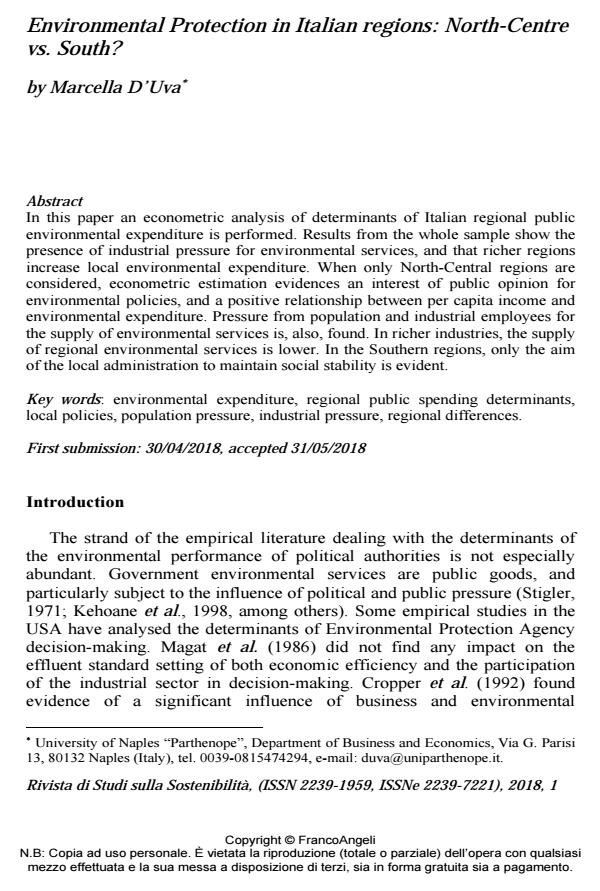Environmental Protection in Italian regions: North-Centre vs. South?
Titolo Rivista RIVISTA DI STUDI SULLA SOSTENIBILITA'
Autori/Curatori Marcella D’Uva
Anno di pubblicazione 2018 Fascicolo 2018/1 Lingua Inglese
Numero pagine 10 P. 25-34 Dimensione file 172 KB
DOI 10.3280/RISS2018-001004
Il DOI è il codice a barre della proprietà intellettuale: per saperne di più
clicca qui
Qui sotto puoi vedere in anteprima la prima pagina di questo articolo.
Se questo articolo ti interessa, lo puoi acquistare (e scaricare in formato pdf) seguendo le facili indicazioni per acquistare il download credit. Acquista Download Credits per scaricare questo Articolo in formato PDF

FrancoAngeli è membro della Publishers International Linking Association, Inc (PILA)associazione indipendente e non profit per facilitare (attraverso i servizi tecnologici implementati da CrossRef.org) l’accesso degli studiosi ai contenuti digitali nelle pubblicazioni professionali e scientifiche
In this paper an econometric analysis of determinants of Italian regional public environmental expenditure is performed. Results from the whole sample show the presence of industrial pressure for environmental services, and that richer regions increase local environmental expenditure. When only North-Central regions are considered, econometric estimation evidences an interest of public opinion for environmental policies, and a positive relationship between per capita income and environmental expenditure. Pressure from population and industrial employees for the supply of environmental services is, also, found. In richer industries, the supply of regional environmental services is lower. In the Southern regions, only the aim of the local administration to maintain social stability is evident.
Keywords:Environmental expenditure, regional public spending determinants, local policies, population pressure, industrial pressure, regional differences.
- Arellano M. (1993). On the testing of correlated effects with panel data. Journal of Econometrics, 1-2: 87-97.
- Cropper M.L., Evans W.N., Berardi S.J., Ducla-Soares M.M., and Portney P.R. (1992). The Determinants of Pesticide Regulation: A Statistical Analysis of EPA Decision Making. Journal of Political Economy, 100: 175-97.
- De Siano R., D’Uva M. (2016). Fiscal decentralization and spillover effects of local government public spending: the case of Italy. Regional Studies, DOI: 10.1080/00343404.2016.1208814
- Grossman G.M., Helpman E. (1994). Protection for Sale. American Economic Review, 84: 833-850.
- Hansen L. (1982). Large sample properties of generalized method of moments estimators. Econometrica, 50(3): 1029-1054.
- Keohane N.O., Revesz R., and Stavins R.N. (1998). The Choice of Regulatory Instruments in Environmental Policy. Harvard Environmental Law Review, 22: 313-67.
- Magat W.A., Krupnick A.J., and Harrington W. (1986). Rules in the Making: A Statistical Analysis of Regulatory Agency Behavior. Washington, DC: Resources for the Future.
- Sargan J. (1958). The estimation of economic relationships using instrumental variables. Econometrica, 26(3): 393-415
- Stigler G. (1971). The Theory of Economic Regulation. Bell Journal of Economics and Management Sciences, 2: 3-21.
- Wang H., Di W. (2002). The Determinants of Government Environmental Performance: An Empirical Analysis of Chinese Townships. World Bank Policy Research Working Paper 293.
- Wang H. and Y. Jin (2002). Industrial Ownership and Environmental Performance: Evidence from China. Policy Research Working Paper of the World Bank.
- Wooldridge J.M. (2002). Econometric Analysis of Cross Section and Panel Data. Cambridge, MA: MIT Press
- Don’t save lemons! The impact of older technology vehicles on environmental expenditure at regional level in Italy Elina De Simone, Marcella D'Uva, Salvatore Ercolano, in Ecological Indicators 105540/2019 pp.105540
DOI: 10.1016/j.ecolind.2019.105540
Marcella D’Uva, Environmental Protection in Italian regions: North-Centre vs. South? in "RIVISTA DI STUDI SULLA SOSTENIBILITA'" 1/2018, pp 25-34, DOI: 10.3280/RISS2018-001004